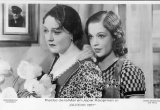Trade Journals and Fan Magazines
The first film magazines came on the scene around 1907. Great Britain published ‘The Kinematograph and Lantern Weekly’ (successor of the ‘Optical Lantern and Cinematograph Journal’), and the similarly named ‘Kinematograph’ was started up around the same time in Germany. Both periodicals focused on the film industry itself – the growing professional group of cinema owners, distributors and travelling cinema showmen. These magazines were full of information for these new businessmen: new films were recommended, economic problems were discussed, and film-related social issues were tackled.
Missing issues – no Dutch film magazines
The Netherlands wasn’t so fortunate in this regard. Occasionally there were a few newspaper articles published about film, but mainly people had to rely on photography magazines such as ‘Focus’ for film information. Magazines at that time primarily concentrated on the technical aspects of photography and film. Besides these publications there was ‘De komeet’, the magazine for fairground showmen. It covered film when it was relevant to travelling cinema in the early years.
It wasn’t until 1912 that the first film magazine debuted in the Netherlands. It was called ‘De Bioscoop-Courant’. Like its aforementioned British and German predecessors, this magazine was made for the cinema business; it was a place to share information and to stand up for the interests of their sector. One example of this was lobbying for a national film censorship board in order to avoid the arbitrariness of local cinema boards.
In addition to ‘De Bioscoop-Courant’, a second periodical appeared on the market in 1913: ‘De kinematograaf’. This magazine also focused on the film sector but had a different, more critical tone to it and also addressed the shortcomings of the film business itself. In 1919, the magazine became ‘De film’, which would exist until mid-1920.
An offical organ
Starting in February 1918, the Nederlandsche Bioscoopbond used ‘De Bioscoop-Courant' as its official publication until it was succeeded by the weekly ‘Kunst en amusement’. This remained so until Pier Westerbaan, the editor-in-chief of ‘Kunst en amusement’ started up his own magazine called ‘Nieuw weekblad voor de cinematografie’. This was the beginning of the end for ‘Kunst en amusement’, which eventually went out of business in 1927.
Westerbaan’s weekly was published until 1976, and for a long time it was the magazine of choice for the Dutch film industry. Just as ‘De Bioscoop-Courant’ had done before it, ‘Nieuw weekblad’ battled against the alleged opponents of the film business – the press and local governments – and against the film union’s enemies. Like its predecessors, the ‘Nieuw weekblad’ subsisted to a great extent on advertisements from distributors for their new films.
Another magazine, another angle
While all of the above-mentioned magazines were written primarily for the film business, the first periodical for a broader audience, ‘De Film-Wereld’ was launched in 1918. Pier Westerbaan was the editor-in-chief for this magazine during its early years. In 1921, ‘De Film-Wereld’ was renamed ‘Cinema en Theater.’ This publication lasted until 1944. Along with Het nieuw weekblad, ‘Cinema en Theater’ was vital to the film world’s image during the interwar period.
more information
If you are looking for more material from our collection, please contact Film Sales:
sales@eyefilm.nl
phone +31 (0)20 5891 426
